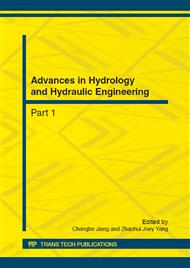[1]
Pierson,W.J, Moskowitz,L. A proposed spectral form for fully developed wind seas based on the similarity theory of S.A. Kitaigorodskii. J Geophys Res, 69,5181-90. (1964).
DOI: 10.1029/jz069i024p05181
Google Scholar
[2]
Hasselmann, K.,Barnett, T. P., Bouws, E., et al. Measurements of wind-wave growth and swell decay during the Joint North Sea Wave Project (JONSWAP). Deutschen Hydrographischen Zeitschrift, A8(12):95. (1973).
Google Scholar
[3]
Toba,Y. Local balance in the air–sea boundary process. J Oceanogr Soc Japan,29,209-20. (1973).
Google Scholar
[4]
Mitsuyasu, H.,F. Tasai,T. Suhara, et al. Observations of the power spectrum of waves using a cloverleaf buoy.J Phys Oceanogr,10,286-96. (1980).
DOI: 10.1175/1520-0485(1980)010<0286:ootpso>2.0.co;2
Google Scholar
[5]
Forristall, G. Z. Measurements of a saturation range in ocean wave spectra.J Geophys Res,86,8075-84. (1981).
Google Scholar
[6]
Kahma K.K. A study of the growth of the wave spectrum with fetch. J Phys Oceanogr,11,1503-15. (1981).
DOI: 10.1175/1520-0485(1981)011<1503:asotgo>2.0.co;2
Google Scholar
[7]
Donelan M.A.,J.Hamilton, W.H. Hui. Directional spectra of wind-generated waves. Philos Trans RSoc London A,315,509-62. (1985).
Google Scholar
[8]
Miller, H.C. and Vincent, C.L. FRF spectrum: TMA with Kitaigorodskii's f-4 scaling. ASCE J.Waterw. Port Coastal Ocean Div,116,57-78. (1990).
DOI: 10.1061/(asce)0733-950x(1990)116:1(57)
Google Scholar
[9]
Young I.R. and Babanin A.V. The form of the asymptotic depth-limited wind wave frequency spectrum.J Geophys Res ,Vol.111,c06031. (2006).
DOI: 10.1029/2005jc003398
Google Scholar
[10]
Ochi, M.K. On hurricane-generated seas. In: Proceedings of the Second International Symposium on Ocean Wave Measurement and Analysis, New Orleans. ASCE, New York, pp.374-387. (1993).
Google Scholar
[11]
Chakrabarti, S.K. Handbook of Offshore Engineering, vol. 1.Ocean Engineering Series. Elsevier, Amsterdam, p.661. (2005).
Google Scholar
[12]
Kumar, V.S. and, K.Ashok., Kumar. Spectral characteristics of high shallow water waves. Ocean Engineering,35, 900-911. (2008).
DOI: 10.1016/j.oceaneng.2008.01.016
Google Scholar
[13]
Young, I. R., and L. A. Verhagen. The growth of fetch limited waves in water of finite depth. part II: Spectral evolution, Coastal Eng. 28, 79-100. (1996).
DOI: 10.1016/s0378-3839(96)00007-5
Google Scholar
[14]
Young, I.R. A review of the sea state generated by hurricanes.Marine Structures 16, 201–218. (2003).
DOI: 10.1016/s0951-8339(02)00054-0
Google Scholar


